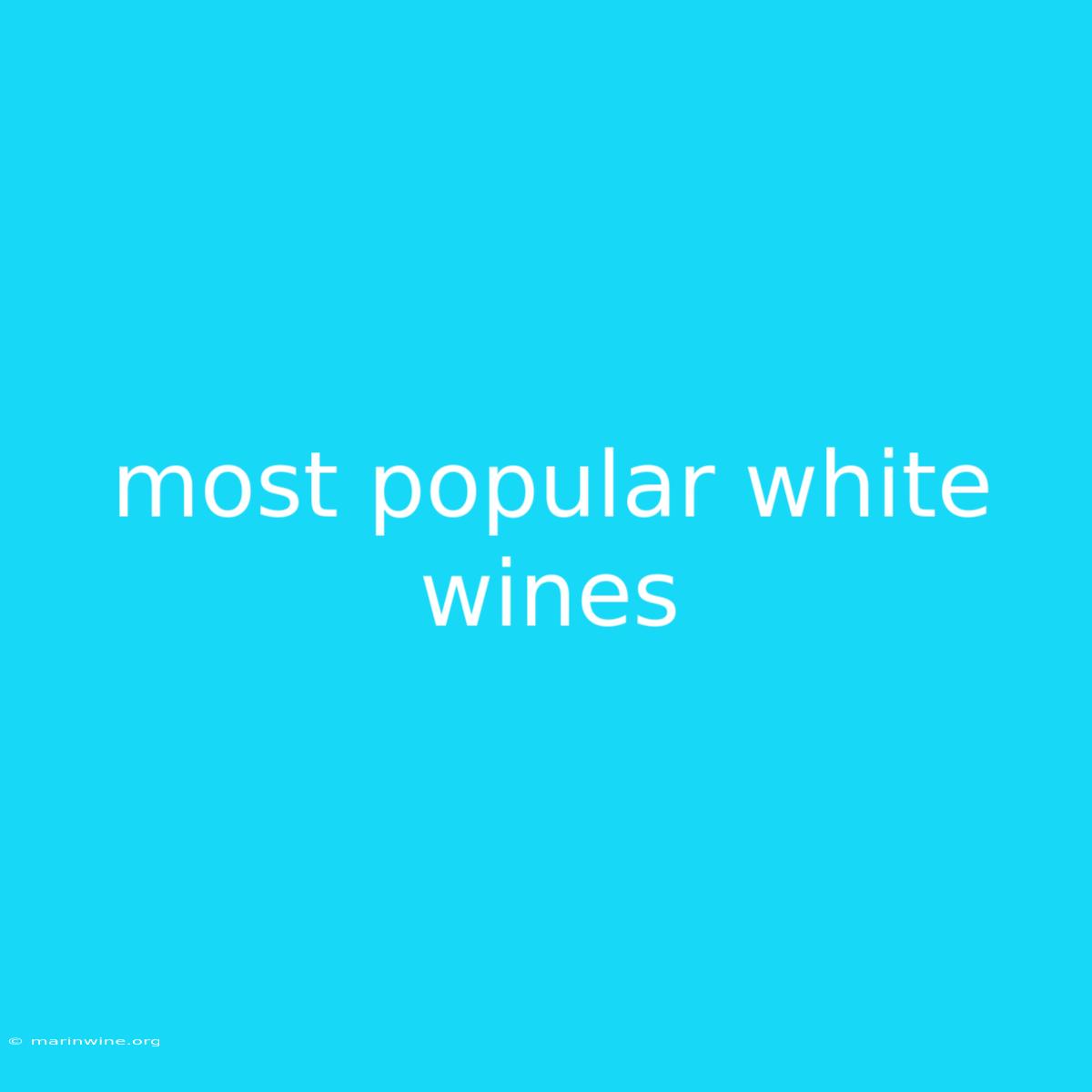Uncorking the Delights: Exploring the World's Most Popular White Wines
Have you ever wondered what makes a white wine truly popular? It's not just about its refreshing taste; it's a captivating combination of flavor profiles, versatility, and a touch of cultural influence. This article dives into the world of popular white wines, revealing the key aspects that make them crowd-pleasers.
Why It Matters:
This guide is crucial for wine enthusiasts and newcomers alike. It provides insights into the most popular white wines, helping you understand their characteristics, tasting notes, and ideal food pairings. It also explores the cultural significance and production methods that contribute to their widespread popularity.
Key Takeaways:
| Key Aspect | Description |
|---|---|
| Versatility: | These wines pair well with a wide range of dishes, from light appetizers to rich seafood. |
| Accessibility: | They are readily available at most wine shops and restaurants. |
| Price Range: | Options exist for every budget, from entry-level to premium selections. |
| Global Appeal: | These wines are enjoyed worldwide, making them perfect for any occasion. |
Exploring the World's Most Popular White Wines:
1. Sauvignon Blanc
Introduction: Renowned for its crisp acidity and vibrant fruit flavors, Sauvignon Blanc is a popular choice for those seeking a refreshing and zesty white wine.
Key Aspects:
- Distinct Aroma: Known for its characteristic "grassy" notes, often accompanied by citrus, passionfruit, and sometimes even gooseberry.
- Regional Variations: Styles can vary depending on origin, with New Zealand offering a more intense, tropical character, while French Sancerre showcases a leaner, minerally profile.
- Food Pairings: Exquisite with seafood, salads, and goat cheese.
2. Chardonnay
Introduction: Chardonnay is a versatile grape varietal capable of producing wines ranging from lean and crisp to rich and buttery.
Key Aspects:
- Oak Influence: Oak aging, a common practice for Chardonnay, imparts complex flavors of vanilla, toast, and hazelnut.
- Body and Texture: Chardonnay can range from light-bodied and crisp to full-bodied and creamy, depending on the winemaking techniques.
- Food Pairings: Pairs beautifully with chicken, fish, pasta, and even roasted vegetables.
3. Pinot Grigio/Pinot Gris
Introduction: A light-bodied, dry white wine known for its delicate fruit flavors and crisp acidity.
Key Aspects:
- Regional Character: Italian Pinot Grigio is typically lighter and crisp, while Alsace Pinot Gris from France exhibits a more full-bodied, aromatic profile.
- Fruit and Floral Notes: Flavors of green apple, pear, citrus, and subtle floral hints.
- Food Pairings: Excellent with seafood, salads, and lighter pasta dishes.
4. Riesling
Introduction: Riesling is renowned for its versatility, ranging from bone-dry to intensely sweet, and is known for its aromatic character.
Key Aspects:
- Mineral Notes: Riesling often exhibits a distinct "petrol" aroma, especially in German Rieslings.
- Fruit and Floral Aromas: Flavors include citrus, apple, pear, peach, and floral notes, with sweetness levels varying depending on the style.
- Food Pairings: Pairs well with spicy Asian dishes, seafood, and lighter desserts.
5. Moscato
Introduction: This sweet, aromatic wine is known for its light, bubbly character and refreshing fruit flavors.
Key Aspects:
- Low Alcohol Content: Typically low in alcohol, making it a good choice for light drinking.
- Sweetness: Moscato is known for its distinct sweetness, often accompanied by fruity notes like peach, apricot, and citrus.
- Food Pairings: Enjoy with desserts, fruit salads, and light appetizers.
FAQ:
Introduction: This section addresses common questions about popular white wines.
Q: What is the difference between Pinot Grigio and Pinot Gris? A: They are the same grape, but Pinot Grigio refers to the Italian style, while Pinot Gris is the French style.
Q: What is the best way to serve white wine? A: Chill white wines to the recommended temperature before serving, usually between 45-55 degrees Fahrenheit.
Q: How do I know if a white wine is good? A: Look for a wine that is clear and bright, with no cloudiness or sediment.
Q: How can I learn more about white wines? A: Explore wine shops, attend wine tastings, and read online resources to expand your knowledge.
Tips for Enjoying White Wines:
Introduction: These tips can enhance your white wine experience.
1. Serve in the right glass: Use a white wine glass with a wider bowl to allow aromas to develop. 2. Decant for optimal flavor: Decanting some white wines can soften the tannins and enhance the flavors. 3. Pair with the right food: Explore different food pairings to discover exciting flavor combinations. 4. Experiment with different regions: Try white wines from diverse regions to experience a variety of styles. 5. Learn the tasting notes: Pay attention to the aromas, flavors, and finish of the wine to appreciate its nuances.
Summary:
This article explored the world's most popular white wines, offering insights into their unique characteristics, flavor profiles, and cultural significance. By understanding the qualities that make these wines stand out, you can make informed choices and enhance your appreciation for this beloved beverage.
Closing Message:
The world of white wine is a fascinating landscape full of diverse flavors and captivating stories. Embrace the journey of discovery, explore new varieties, and continue to enjoy the pleasures of this refreshing and delightful drink.

